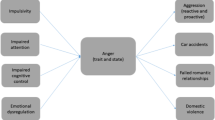Abstract
Consistent with the cognitive-neoassociationistic conception of anger and emotional aggression, a wide variety of studies with animal as well as human subjects demonstrate that pain often gives rise to an inclination to hurt an available target, and also, at the human level, that people in pain are apt to be angry. However, and also in accord with the present formulation, these “primitive” angry/aggressive reactions can be suppressed, intensified, or modified by cognitive processes.
Similar content being viewed by others
References
Anderson, C. A. (1989). Temperature and aggression: Ubiquitous effects of heat on occurrence of human violence.Psychological Bulletin, 106 74–96.
Archer, J. (1990). Pain-induced aggression: An ethological perspective.Current Psychology: Research and Reviews, 8 298–306.
Azrin, N. H., Hutchinson, R. R., & Hake, D. F. (1966). Extinction-induced aggression.Journal of the Experimental Analysis of Behavior, 9 191–204.
Azrin, N. H., Hutchinson, R. R., & McLaughlin, R. (1965). The opportunity for aggression as an operant reinforcer during aversive stimulation.Journal of the Experimental Analysis of Behavior, 8 171–180.
Bandura, A. (1973).Aggression: A social learning analysis. Englewood Cliffs, NJ: Prentice-Hall.
Baron, R. A. (1977).Human aggression. New York: Plenum Press.
Berkowitz, L. (1974). Some determinants of impulsive aggression: Role of mediated associations with reinforcements for aggression.Psychological Review, 81 165–176.
Berkowitz, L. (1982). Aversive conditions as stimuli to aggression. In L. Berkowitz (Ed.),Advances in experimental social psychology. New York: Academic Press.
Berkowitz, L. (1983). Aversively stimulated aggression: Some parallels and differences in research with animals and humans.American Psychologist, 38 1135–1144.
Berkowitz, L. (1989). The frustration-aggression hypothesis: An examination and reformulation.Psychological Bulletin, 106 59–73.
Berkowitz, L. (1990). On the formation and regulation of anger and aggression: A cognitive-neoassociationistic analysis.American Psychologist, 45 494–503.
Berkowitz, L. (1993a).Aggression: Its causes, consequences, and control. New York: McGraw-Hill.
Berkowitz, L. (1993b). Towards a general theory of anger and emotional aggression: Implications of the cognitive-neoassociationistic perspective for the analysis of anger and other emotions. In R. S. Wyer, Jr., & T. K. Srull (Eds.),Advances in social cognition: Vol. 6. Perspectives on anger and emotion. Hillsdale, NJ: Erlbaum.
Berkowitz, L., Cochran, S., & Embree, M. (1981). Physical pain and the goal of aversively stimulated aggression.Journal of Personality and Social Psychology, 40 687–700.
Berkowitz, L., & Embree, M. C. (1987). The effect of escape possibility on aversively stimulated aggression.Journal of Research in Personality, 21 405–416.
Berkowitz, L., & Thome, P. R. (1987). Pair expectation, negative affect, and angry aggression.Motivation and Emotion, 11 183–193.
Berkowitz, L., & Troccoli, B. T. (1990). Feelings, direction of attention, and expressed evaluations of others.Cognition and Emotion, 4 305–325.
Blanchard, R. J., Blanchard, D. C., & Takahishi, L. K. (1978). Pain and aggression in the rat.Behavioral Biology, 23 291–305.
Brain, P. F. (1981). Differentiating types of attack and defense in rodents. In P. F. Brain and D. Benton (Eds.),Multidisciplinary approaches to aggression research (pp. 53–78). Amsterdam/New York/Oxford; Elsevier North-Holland.
Ferguson, T. J., and Rule, B. G. (1983). An attributional perspective on anger and aggression. In R. G. Geen and E. I. Donnerstein (Eds.),Aggression: Theoretical and empirical reviews. New York: Academic Press.
Feshbach, S. (1964). The function of aggression regulation of aggressive drive.Psychological Review, 71 257–272.
Geen, R. G. (1990).Human aggression. Milton Keynes, UK: Open University Press.
Hartmann, D. P. (1969). Influence of symbolically modeled instrumental aggression and pain cues on aggressive behavior.Journal of Personality and Social Psychology, 11 280–288.
Hatch, J. P., Moore, P. J., Borcherding, S., Cyr-Provost, M., Boutros, N. N., & Seleshi, E. (1992). Electromyographic and affective responses of episodic tension-type headache patients and headache-free controls during stressful task performance.Journal of Behavioral Medicine, 15 89–112.
Hutchinson, R. R. (1983). The pain-aggression relationship and its expression in naturalistic settings.Aggressive Behavior, 9 229–242.
Hutchinson, R. R., Renfrew, J. W., & Young, G. A. (1971). Effects of long-term shock and associated stimuli on aggressive and manual responses.Journal of the Experimental Analysis of Behavior, 15 141–166.
Knutson, J. F., Fordyce, D. J., & Anderson, D. J. (1980). Escalation of irritable aggression: Control by consequences and antecedents.Aggressive Behavior, 6 347–359.
Leventhal, E. A., Leventhal, H., Shacham, S., & Easterling, D. V. (1989). Active coping reduces reports of pain from childbirth.Journal of Consulting and Clinical Psychology, 57 365–371.
Leventhal, H., Brown, D., Shacham, S., & Engquist, S. (1979). The effects of preparatory information about sensations, threat of pain, and attention on cold pressor distress.Journal of Personality and Social Psychology, 37 970–985.
Mathew, N. T. (1990). Advances in cluster headache.Neurologic Clinics, 8 867–890.
Melzack, R. (1973).The Puzzle of Pain. New York: Basic Books.
Moyer, K. E. (1976).The psychobiology of aggression. New York: Harper & Row.
Potegal, M. (1979). The reinforcing value of several types of aggressive behavior: A review.Aggressive Behavior, 5 353–373.
Schneider, W., Dumais, S. T., & Shiffrin, R. M. (1984). Automatic and control processing and attention. In R. Parasuraman & D. R. Davies (Eds.),Varieties of attention (pp 1–27). New York: Academic Press.
Sternbach, R. A. (1978).The psychology of Pain. New York: Raven Press.
Summers, J. D., Rapoff, M. A., Varghese, G., Porter, K., & Palmer, R. E. (1991). Psychosocial factors in chronic spinal cord injury pain.Pain, 47 183–189.
Swart, C., & Berkowitz, L. (1976). The effect of a stimulus associated with a victim's pain on later aggression.Journal of Personality and Social Psychology, 33 623–631.
Ulrich, R. E. (1966). Pain as a cause of aggression.American Zoologist, 6 643–662.
Ulrich, R. E., & Azrin, N. H. (1962). Reflexive fighting in response to aversive stimulation.Journal of the Experimental Analysis of Behavior, 5 511–520.
Vernon, W., & Ulrich, R. (1966). Classical conditioning of pain-elicited aggression.Science, 152 668.
Wade, J. B., Price, D. D., Hamer, R. M., Schwartz, S. M., & Hart, R. P. (1990). An emotional component analysis of chronic pain.Pain, 40 303–310.
Weiner, B. (1985). An attributional theory of achievement motivation and emotion.Psychological Review, 92 548–573.
Author information
Authors and Affiliations
Rights and permissions
About this article
Cite this article
Berkowitz, L. Pain and aggression: Some findings and implications. Motiv Emot 17, 277–293 (1993). https://doi.org/10.1007/BF00992223
Issue Date:
DOI: https://doi.org/10.1007/BF00992223




